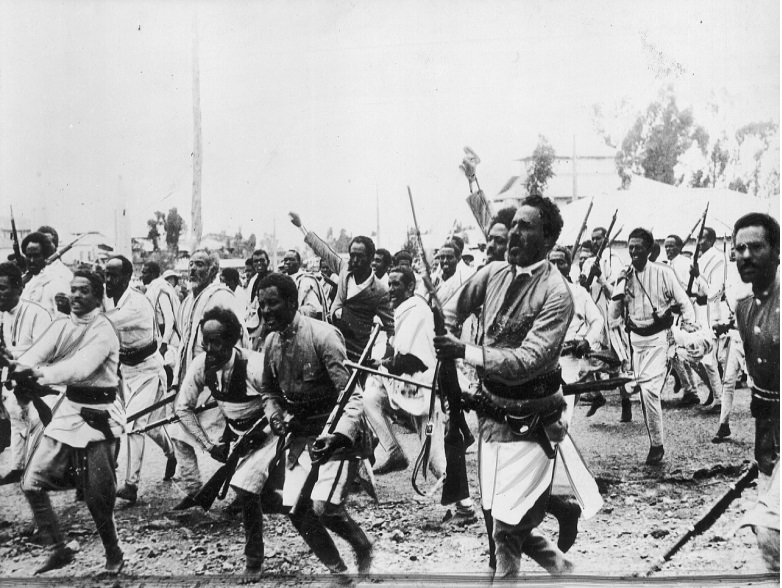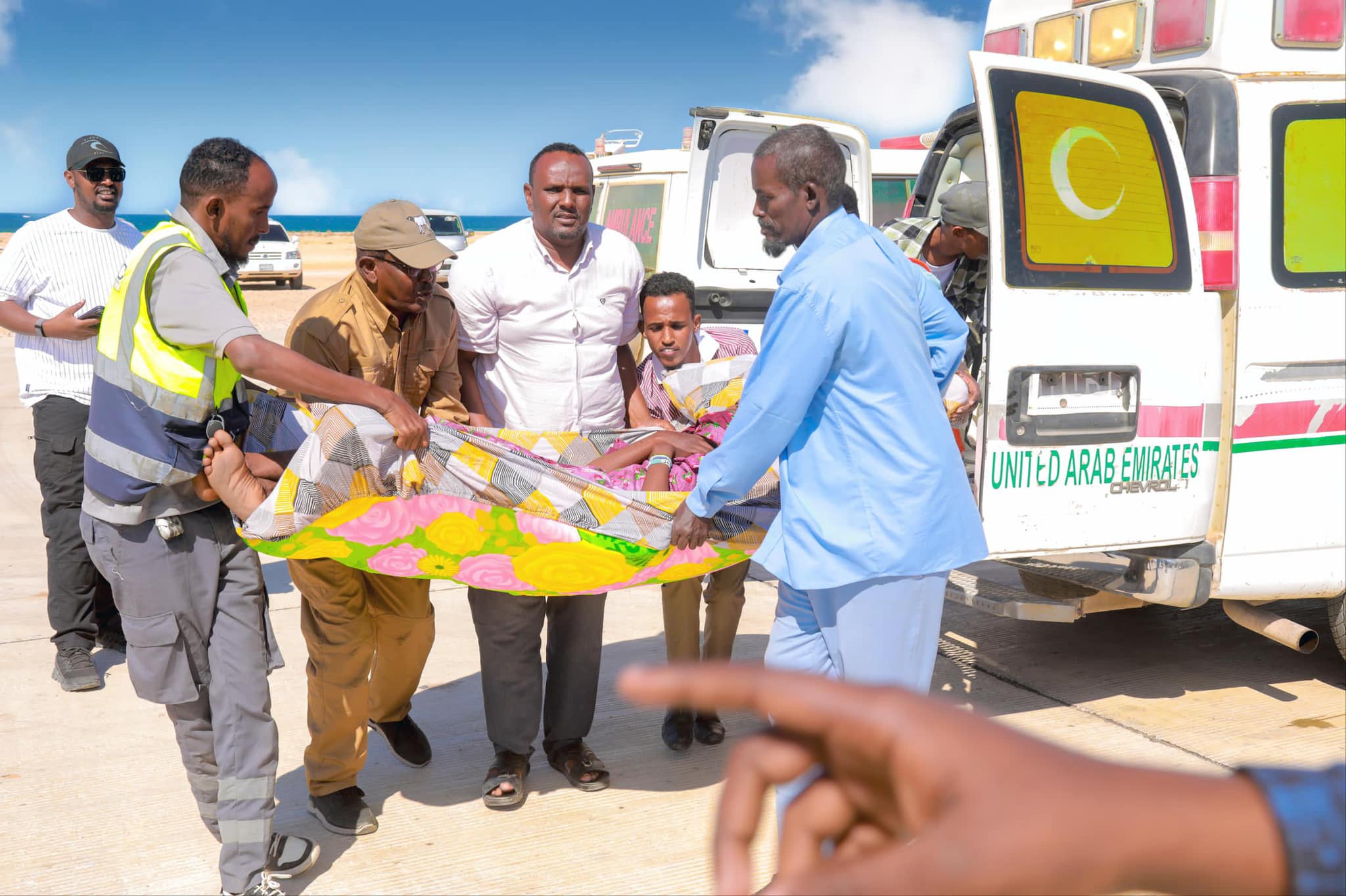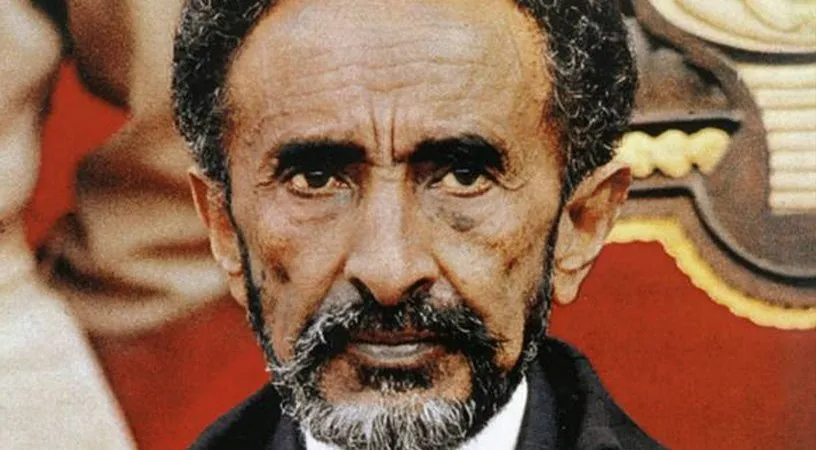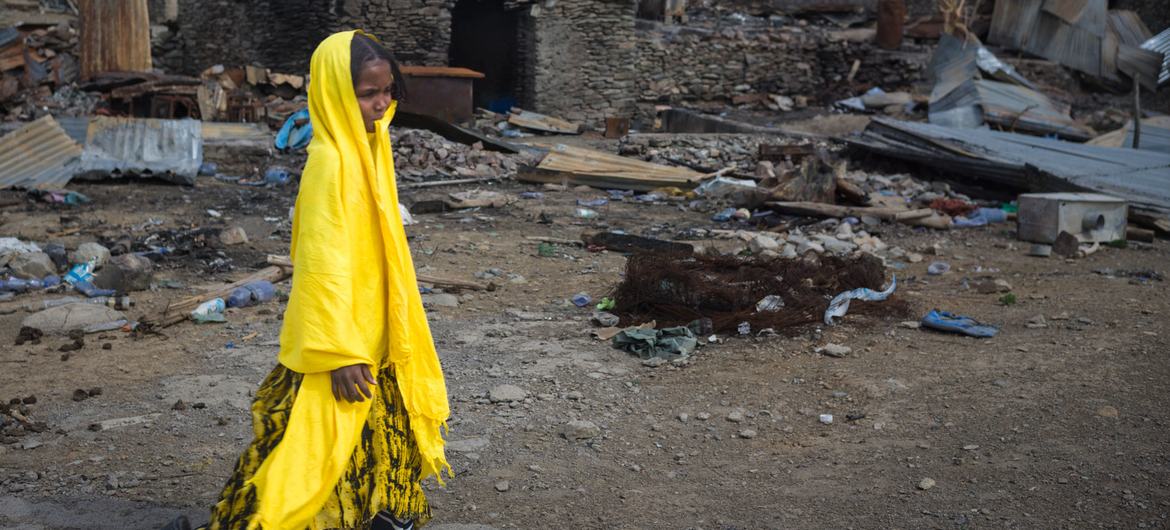 The photo is of Ethiopian warriors going to the northern front during the Second Italo-Ethiopian War (Photographs available at www.audiovis.nac.gov.pl are public domain or the owner of the copyrights is the State Treasury of Poland, represented by the National Digital Archive)
The photo is of Ethiopian warriors going to the northern front during the Second Italo-Ethiopian War (Photographs available at www.audiovis.nac.gov.pl are public domain or the owner of the copyrights is the State Treasury of Poland, represented by the National Digital Archive)
By Caleb Tadesse (Dr.)
November 25, 2024
Introduction
The colonial experience in Africa is often marked by the direct imposition of European rule on African territories, but Ethiopia represents a unique case in the history of African colonialism. It is the only African nation to successfully resist European colonization, largely due to the victory at the Battle of Adwa in 1896. However, Italy’s colonial ambitions in Ethiopia were not entirely quashed, and between 1936 and 1941, during the second Italian invasion of Ethiopia, a genocidal campaign was launched against the Ethiopian people, particularly targeting the Amhara ethnic group. This article explores Italy’s historical narratives surrounding its colonial ambitions in Ethiopia, the nature of the genocide against the Amhara, and the complex legacy of these events within the context of colonialism in Africa.
Italy’s Historical Narratives and Colonial Ambitions in Ethiopia
Italy’s interest in colonizing Ethiopia began in the late 19th century, spurred by the broader European “Scramble for Africa.” The Battle of Adwa (1896), however, was a significant blow to Italy’s imperial ambitions, as Ethiopian forces under Emperor Menelik II decisively defeated the Italian army, forcing Italy to recognize Ethiopian sovereignty under the Treaty of Addis Ababa. Despite this setback, Italy never completely abandoned its colonial aspirations in the Horn of Africa.
In the early 20th century, Italy sought to consolidate its presence in East Africa, eventually succeeding in colonizing Eritrea (1890) and later Somalia. Italy’s failure in Ethiopia remained a stain on its imperialist narrative, which would later influence its actions under the regime of Benito Mussolini. Following Mussolini’s rise to power in 1922, Italy adopted an aggressive fascist policy that sought to reclaim Italy’s imperial prestige and expand its colonial holdings. The invasion of Ethiopia in 1935 was driven by both strategic ambitions and the desire to avenge the Italian defeat at Adwa (Pankhurst, 1990).
The Second Italian Invasion and the Amhara Genocide
The second Italian invasion of Ethiopia began in October 1935 and culminated in the Italian occupation of Addis Ababa in May 1936. Mussolini framed the invasion as a civilizing mission to bring modernity to Ethiopia, but the reality was much more brutal. The occupation was marked by widespread atrocities against the Ethiopian population, especially the Amhara people.
The Amhara, who were the dominant ethnic group in the Ethiopian Empire, were particularly targeted by Italian forces due to their perceived political and social power. During the occupation, Italy employed a strategy of terror to quell resistance, using chemical weapons, mass executions, and forced labor to suppress the Ethiopian population (Henze, 2000). Thousands of Amhara men, women, and children were killed in massacres, and entire villages were destroyed. The Italian occupation forces were also known to have carried out systematic extermination campaigns, with some historians estimating that up to 275,000 Ethiopians were killed during this period (Moller, 2019).
One of the most notorious aspects of the Italian occupation was the use of poison gas, which Italy had developed and deployed during the Second Italo-Ethiopian War. The Italians used mustard gas and other chemical agents in an attempt to break the Ethiopian resistance, killing thousands of civilians. The Amhara, being the ethnic group, most heavily involved in the resistance, suffered disproportionately from these attacks.
The genocide also included the widespread use of concentration camps, where Ethiopians, particularly the Amhara, were imprisoned, subjected to forced labor, and often executed. The infamous “Adua Massacre” in 1936, where hundreds of Amhara intellectuals, clergy, and community leaders were executed, marked a peak in the genocidal violence aimed at eliminating Ethiopian leadership and suppressing resistance (Robinson, 2015).
Italy’s Narrative of the Invasion: A “Civilizing” Mission?
The Italian government under Mussolini sought to legitimize its invasion through a narrative of bringing civilization to the “barbaric” Ethiopians. This narrative was steeped in the colonial discourse of the time, which framed European powers as the rightful civilizers of “uncivilized” African societies. Mussolini’s regime, heavily influenced by fascist ideologies, justified the invasion as a historical necessity for Italy to regain its honor and secure its place as a world power (De Felice, 1977).
In Italy’s official narratives, the brutality of the occupation was downplayed or justified. The fascist government portrayed the Ethiopian people as incapable of self-governance, positioning the Italian intervention as a benevolent effort to modernize Ethiopia. Mussolini himself referred to the invasion as a “civilizing mission,” a trope common in colonial discourse that masked the brutal reality of imperial domination (Ferro, 1984).
However, these narratives were at odds with the reality of the occupation. Eyewitness accounts, such as those from Italian military officers and foreign diplomats, painted a picture of widespread violence, terror, and destruction (Banti, 2014). The efforts to erase Ethiopian cultural and historical identity during the occupation, including the destruction of religious and historical sites, further contradicted the idea of a benevolent Italian presence.
The Amhara Genocide and Post-Colonial Reflections
The genocide of the Amhara during the Italian occupation of Ethiopia is a poignant reminder of the enduring violence of colonialism. While Ethiopia was never formally colonized, the Italian occupation nonetheless left deep scars on Ethiopian society, particularly among the Amhara people who were disproportionately targeted. The genocidal policies carried out by the Italians are often overlooked in mainstream discussions of African colonialism, perhaps because Ethiopia is often regarded as the only African country to have successfully resisted colonization.
The Amhara genocide has not been as widely studied as other genocides, such as the Holocaust or the Rwandan Genocide, but it deserves greater attention in the context of colonial violence. In recent years, there has been a growing recognition of the atrocities committed by Italian forces in Ethiopia, with calls for official apologies and reparations from the Italian government (Kepel, 2019). The denial of these historical atrocities by the Italian government, as well as the portrayal of the occupation as a benign endeavor, remains a contentious issue in the relationship between Ethiopia and Italy.
Abiy Ahmed’s Rise and the Resurgence of Colonial Narratives
The narratives of ethnic hierarchy and oppression that originated during Italy’s colonial period have been weaponized in the political discourse of contemporary Ethiopia. In particular, the demonization of the Amhara elite, who have been portrayed as oppressors in both colonial and post-colonial rhetoric, has continued under Abiy Ahmed’s government. This is especially evident in the ongoing ethnic violence and military campaigns where the Amhara have been both perpetrators and victims. Tensions with the Tigray, Oromo, and other ethnic groups, many of whom have their roots in the resistance movements that fought against Italian occupation, have resurfaced in violent confrontations. These tensions have been exacerbated by the use of military tactics that recall the brutal methods employed by colonial powers.
The Role of Abiy Ahmed Military Force: Drones, Jets, and Mortars
Under Abiy Ahmed’s leadership, Ethiopia has increasingly relied on modern military technology, including drones, helicopters, jet fighters, tanks, and mortars, to suppress dissent and fight insurgencies. The most dramatic example of this military escalation has been during the Amhara War which erupted in late 2022 and escalated into a full-scale conflict involving heavy airstrikes, artillery bombardments, and ground operations. Drones, in particular, have been used extensively, marking a shift towards high-tech warfare in a region that has long been characterized by guerrilla tactics and irregular warfare.
This heavy-handed military strategy mirrors the tactics used by the Italians during their occupation of Ethiopia. Italy’s use of chemical weapons, aerial bombardments, and mass executions was designed to break the spirit of Ethiopian resistance (Sbacchi, 1985). In the 21st century, Abiy’s use of drones and airstrikes represents a technological evolution of the colonial state’s military tactics, suggesting a continuity of violence directed at suppressing perceived threats to state authority, especially in regions with historical resistance movements.
The Ethiopian government’s actions in regions like Tigray, Amhara, and Wellega have been widely condemned by human rights organizations for targeting civilians, using indiscriminate force, and committing atrocities. The legacy of Italian colonial violence, therefore, is not only reflected in the ethnic violence and propaganda that continue to shape Ethiopian politics but also in the brutal military tactics employed by the current government.
The Weaponization of Genocide: Abiy Ahmed’s Military Forces and the Massacre of the Amhara
- Use of Drones and Jets:Abiy Ahmed’s government has employed modern military technology, including drones and jets, in conflicts across the country, particularly in the Amhara war that began in late 2022. The Amhara region has seen frequent airstrikes, with the Ethiopian Air Force accused of targeting civilian areas, markets, and refugee camps, leading to significant casualties among the Amhara people.
Drone strikes are being used in various regions, including areas with significant Amhara populations. These strikes are particularly devastating as they leave little room for defense or escape, and their precision and scale make them an effective tool for state-led repression. Additionally, the use of jets to drop bombs on civilian targets has intensified the suffering of Amhara communities, causing widespread displacement, destruction, and loss of life.
- Mortar Shelling and Ground Troops:Ground troops, supported by mortars and artillery, have been used in targeted campaigns against the Amhara people. The Ethiopian military has launched coordinated attacks on Amhara villages, towns, and refugee camps, often indiscriminately shelling areas inhabited by civilians. The use of mortars in these attacks has resulted in the destruction of homes, schools, and essential infrastructure, exacerbating the humanitarian crisis.
The continued targeting of the Amhara by the military, coupled with the employment of heavy artillery and ground forces, suggests that the violence is not random but rather part of a larger plan to erase or subjugate a significant portion of the Amhara population.
- Ethnic Cleansing and Genocide:The massacres and violent repression of the Amhara people under Abiy Ahmed’s rule have raised alarms about the possibility of an ongoing genocide. The UN has highlighted widespread killings, forced displacements, and sexual violence targeted at the Amhara, which are consistent with the definitions of genocide under international law, particularly the intent to destroy, in whole or in part, an ethnic, racial, or religious group.
The massacres of the Amhara are not isolated incidents but part of a broader pattern of state-sponsored violence. Several human rights organizations, including Human Rights Watch and Amnesty International, have documented the Ethiopian government’s role in ethnic-based violence, where the Amhara have been disproportionately targeted by Abiy Ahmed military force besides armed groups with the tacit approval or direct involvement of the government.
International Reactions and Accountability
International bodies and governments have expressed concern over the atrocities committed against the Amhara, but accountability remains limited. While some reports from the United Nations and independent human rights organizations have documented the violence and its genocidal nature, political and diplomatic considerations often hinder concrete actions to stop the violence or punish perpetrators.
The Ethiopian government, under Abiy Ahmed, has consistently denied accusations of genocide and war crimes, framing the violence as part of internal security operations or ethnic conflicts. This denial, coupled with the restricted access for international observers and the media, has made it difficult to hold Abiy Ahmed’s government accountable for its actions.
Conclusion
The tragedy of colonialism in Ethiopia, particularly during the Italian occupation, is a tragic and often overlooked chapter in African history. Italy’s historical narratives surrounding its colonial ambitions in Ethiopia, particularly in the case of the Amhara genocide, reflect the violence, denial, and contradictions inherent in the European colonial enterprise. Despite never being formally colonized, Ethiopia’s people, particularly the Amhara, endured brutal repression, with consequences that continue to resonate today. Understanding the full scope of this tragedy is essential for acknowledging the ongoing impact of colonialism in Africa and for healing the wounds of the past.
The weaponization of modern military technology, including drones, jets, and mortars, by Abiy Ahmed’s military forces plays a central role in the ongoing violence and potential genocide against the Amhara people. These tools of war have been used to target civilian populations, leading to widespread destruction and loss of life. The persistence of this violence, coupled with the political climate under Abiy Ahmed’s rule, underscores the broader implications for the future of Ethiopia’s ethnic and political landscape.




















Hey Ethiopia! When you gonna pay the 250 billion in US dollars you owe Eritrea? That is the reparation amount as established by international laws when one country invades another country. That is the amount assessed by the world’s best legal and financial experts now teaching at the University of Piccolo Roma. The reparation was determined at a fair market value for the destruction and deaths you caused when you invaded Eritrea at Keren in 1941 and the war you waged on Eritrea in 1952, 1962 and between the years 1962-2002. In all, you have killed 11.6 million Eritreans and I have the names of every one of the victims. Then, between 2018 and 2024 you have been taking away the baggage of my travelers who came to your country to relax and recharge. So what if you found fat gold bars, platinum, 10lbs of washed coffee in each luggage? Let me tell you something. My Eritreans are entitled to do anything in your country. Anything. What’s your problem, Kunta? So, Ethiopia, you are on the hook with the 250 billion in US dollars you owe Eritrea. Start coughing it up now. Otherwise, you know what I signed with el-Sisi and my Arab friends at Villa Mogadishu. It won’t take me a week to get to Addis/Finfinne and hand over the GERD Dam to my master benefactor since 1960 in Al-Qahirah. You’re toast!!!
Ethiopia! You have the following options to avoid obliteration by the mighty army from Piccolo Roma
1) You can pay off your debt to Eritrea of 250 billion US dollars by 10 yearly interest free installments of 25 billion each.
2) Supply Eritrea 1,000 MW of electric free of charge for ever. You will be required to build the power line and all the electrical wiring to every home inside Eritrea.
3) Ship all of your gold, platinum, diamond and all other minerals to Piccolo Roma free of charge.
4) All your agricultural products should be exported to Eritrea for the next 75 years to commemorate your 1st invasion at Keren in 1941. The picture is Ethiopian soldiers invading Eritrea at Keren in 1941.
That’s all you have to do to avoid humiliation. I need to hear from you about this final ultimatum by noon tomorrow in time for Black Friday.